Hamelin, bishop of Le Mans from 1190 to 1214, was a pragmatic and opportunistic figure in the complex relations between the Plantagenet and Capetian dynasties. [1] [2]
Hamelin, bishop of Le Mans from 1190 to 1214, was a pragmatic and opportunistic figure in the complex relations between the Plantagenet and Capetian dynasties. [1] [2]
His episcopal career spanned a period of political transition marked by upheaval, where links with the kings were more the result of personal relationships than institutionalised loyalty. [1] [3]
From the start of his episcopate, Hamelin was confronted with the turbulent succession of the Plantagenets, from Richard the Lionhearted to John Lackland. [4] His resolute attitude towards John, even as a loyal follower of his predecessors, demonstrated the esprit de corps within the episcopate, opposing the king's cruelty towards his nephew Arthur. When Philip Augustus took control of Maine in 1202, Hamelin initially refused to pay homage, but eventually bowed to the seizure of his revenues. [1] [5]
Hamelin's relations with Rome were relatively peaceful, and he even received important missions from the Holy See, a sign of the trust placed in him by Rome. His episcopal government was in line with the Gregorian reform, where he worked alongside influential figures such as Adam de Perseigne and promoted ecclesiastical reforms. [1]
Despite the influence of the Plantagenets on Maine, Hamelin managed to maintain a degree of autonomy and pragmatic thinking in his relations with them, as well as with the Capetians. His middle-of-the-road attitude reflects the complexity of relations between bishops and temporal powers, where personal interests and political considerations often took precedence over institutional loyalties. [1] [6]

An episcopal polity is a hierarchical form of church governance in which the chief local authorities are called bishops. The word "bishop" here is derived via the British Latin and Vulgar Latin term *ebiscopus/*biscopus, from the Ancient Greek ἐπίσκοπος epískopos meaning "overseer". It is the structure used by many of the major Christian Churches and denominations, such as the Catholic, Eastern Orthodox, Oriental Orthodox, Church of the East, Anabaptist, Lutheran, and Anglican churches or denominations, and other churches founded independently from these lineages. Many Methodist denominations have a form of episcopal polity known as connexionalism.

Pope Paschal II, born Ranierius, was head of the Catholic Church and ruler of the Papal States from 13 August 1099 to his death in 1118. A monk of the Abbey of Cluny, he was created the cardinal-priest of San Clemente by Pope Gregory VII (1073–85) in 1073. He was consecrated as pope in succession to Pope Urban II (1088–99) on 19 August 1099. His reign of almost twenty years was exceptionally long for a medieval pope.

Louis VII, called the Younger or the Young to differentiate him from his father Louis VI, was King of France from 1137 to 1180. His first marriage was to Duchess Eleanor of Aquitaine, one of the wealthiest and most powerful women in western Europe. The marriage temporarily extended the Capetian lands to the Pyrenees.

The Basilica of Saint-Denis is a large former medieval abbey church and present cathedral in the commune of Saint-Denis, a northern suburb of Paris. The building is of singular importance historically and architecturally as its choir, completed in 1144, is widely considered the first structure to employ all of the elements of Gothic architecture.

Hugh Capet was the King of the Franks from 987 to 996. He is the founder of and first king from the House of Capet. The son of the powerful duke Hugh the Great and his wife Hedwige of Saxony, he was elected as the successor of the last Carolingian king, Louis V. Hugh was descended from Charlemagne's son Pepin of Italy through his mother and paternal grandmother, respectively, and was also a nephew of Otto the Great.
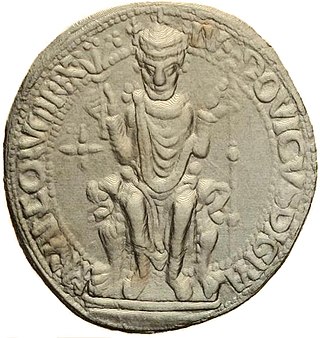
Louis VI, called the Fat or the Fighter, was King of the Franks from 1108 to 1137. Like his father Philip I, Louis made a lasting contribution to centralizing the institutions of royal power. He spent much of his twenty-nine-year reign fighting either the "robber barons" who plagued the Ile de France or Henry I of England for his continental possession of Normandy. Nonetheless, Louis VI managed to reinforce his power considerably, often resorting to force to bring lawless knights to justice, and was the first member of the house of Capet to issue ordonnances applying to the whole of the kingdom of France.
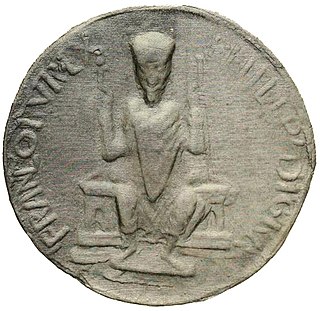
Philip I, called the Amorous, was King of the Franks from 1060 to 1108. His reign, like that of most of the early Capetians, was extraordinarily long for the time. The monarchy began a modest recovery from the low it had reached during the reign of his father, Henry I, and he added the Vexin region and the viscountcy of Bourges to his royal domaine.

Robert II, called the Pious or the Wise, was King of the Franks from 996 to 1031, the second from the Capetian dynasty. Crowned Junior King in 987, he assisted his father on military matters. His solid education, provided by Gerbert of Aurillac in Reims, allowed him to deal with religious questions of which he quickly became the guarantor. Continuing the political work of his father, after becoming sole ruler in 996, he managed to maintain the alliance with the Duchy of Normandy and the County of Anjou and thus was able to contain the ambitions of Count Odo II of Blois.

Anne of Kiev or Anna Yaroslavna was a princess of Kievan Rus who became Queen of France in 1051 upon marrying King Henry I. She ruled the kingdom as regent during the minority of their son Philip I from Henry's death in 1060 until her controversial marriage to Count Ralph IV of Valois. Anne founded the Abbey of St. Vincent at Senlis.
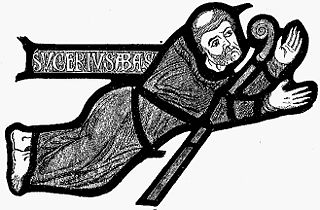
Suger was a French abbot and statesman. He was a key advisor to King Louis VI and his son Louis VII, acting as the latter's regent during the Second Crusade. His writings remain seminal texts for early twelfth-century Capetian history, and his reconstruction of the Basilica of Saint-Denis where he was abbot was instrumental in the creation of Gothic architecture.
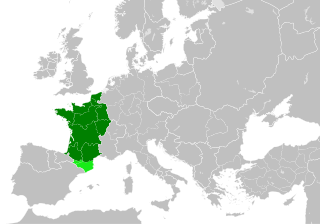
The Kingdom of France in the Middle Ages was marked by the fragmentation of the Carolingian Empire and West Francia (843–987); the expansion of royal control by the House of Capet (987–1328), including their struggles with the virtually independent principalities, and the creation and extension of administrative/state control in the 13th century; and the rise of the House of Valois (1328–1589), including the protracted dynastic crisis against the House of Plantagenet and their Angevin Empire, culminating in the Hundred Years' War (1337–1453), which laid the seeds for a more centralized and expanded state in the early modern period and the creation of a sense of French identity.
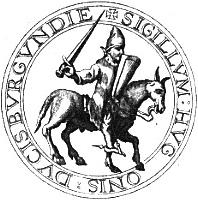
Hugh III was Duke of Burgundy between 1162 and 1192. As duke, Burgundy was invaded by King Philip II and Hugh was forced to sue for peace. Hugh then joined the Third Crusade, distinguishing himself at Arsuf and Acre, where he died in 1192.
Adam of Perseigne was a French Cistercian, abbot of Perseigne Abbey in the Diocese of Le Mans.

The Archdiocese of Sens and Auxerre is a Latin Archdiocese of the Catholic Church in France. The Archdiocese comprises the department of Yonne, which is in the region of Bourgogne. Traditionally established in sub-apostolic times, the diocese as metropolis of Quarta Lugdunensis subsequently achieved metropolitical status. For a time, the Archbishop of Sens held the title "Primate of the Gauls and Germania". Until 1622, the Metropolitan Archdiocese numbered seven suffragan (subordinate) dioceses: the dioceses of Chartres, Auxerre, Meaux, Paris, Orléans, Nevers and Troyes, which inspired the acronym CAMPONT. The Diocese of Bethléem at Clamecy was also dependent on the metropolitan see of Sens. On December 8, 2002, as part of a general reorganization of the dioceses of France undertaken, at least in part, to respond to demographic changes, the Archdiocese of Sens-Auxerre ceased to have metropolitan rank and became a suffragan of the Archdiocese of Dijon, which became the centre of a new ecclesiastical province for the Burgundy administrative region. Consequently the Archbishop of Sens-Auxerre no longer has the privilege of wearing the pallium.

Philip was King of France from 1129 to 1131, co-ruling with his father, Louis VI. As he predeceased his father and never reigned as sole king, he is not known by an ordinal or included in the traditional lists of French monarchs.
Philip of France was a Capetian prince and archdeacon of Paris.

The Capet–Plantagenet feud, also referred to as the "First Hundred Years' War" by some French historians, was a series of conflicts and disputes during the High Middle Ages during which the House of Capet, rulers of the Kingdom of France, fought the House of Plantagenet, rulers of the Kingdom of England. The conflict emerged over the Plantagenet-held Angevin Empire formed by Henry II of England which at its peak covered around half of the territory within France.
Lindy M. Grant is professor emerita of medieval history at the University of Reading, an honorary research fellow of the Courtauld Institute of Art, and a former president of the British Archaeological Association. Grant is a specialist in Capetian France and its neighbours in the 11th to 13th centuries.
The Treasury of Saint-Denis, kept at the Basilica of Saint-Denis in Paris until the French Revolution, was the main repository of the regalia of the Kingdom of France, including the ancien régime portion of what are now known as the French Crown Jewels. Its surviving items are presently scattered between the Louvre, the Cabinet des Médailles of the French National Library, and other museums.
Pierre Charlot,, was the treasurer of St. Martin of Tours, St. Frambaud of Senlis, and St. Fursy of Peronne. He was the illegitimate son of Philip II of France. Elected bishop of Noyon in 1240, Pierre accompanied Louis IX of France on the Seventh Crusade. He died near Cyprus in 1249 and was buried in the cathedral of Noyon.
This article needs additional or more specific categories .(July 2024) |